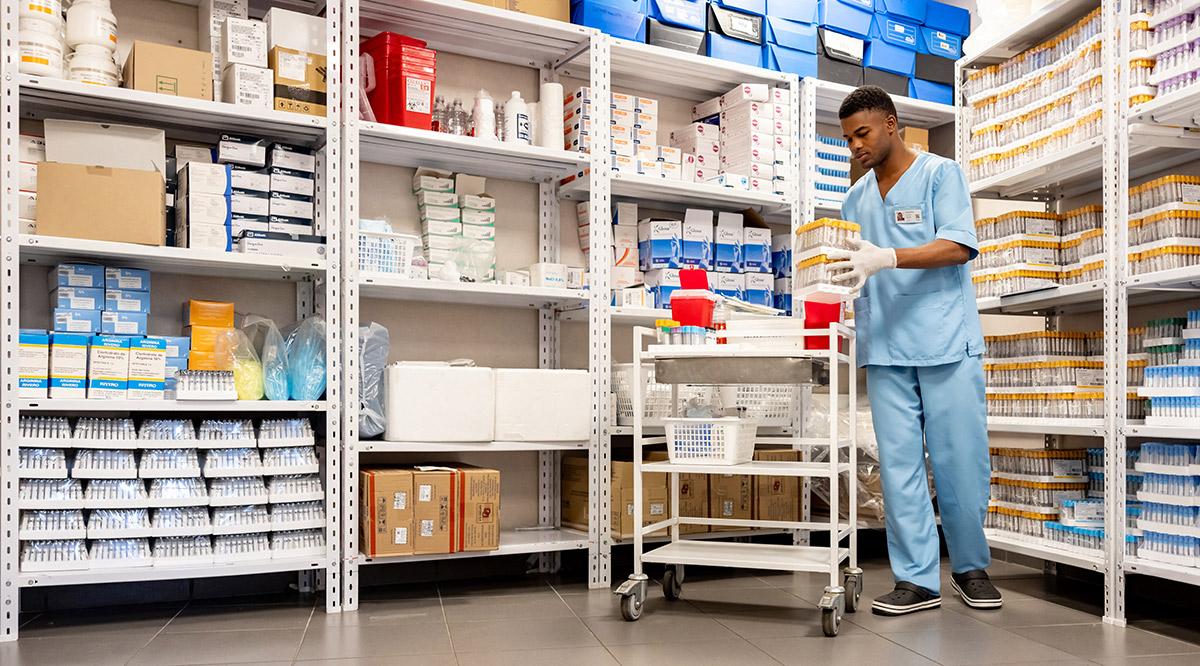The COVID-19 pandemic exposed weaknesses in the U.S. health care supply chain, as lockdowns at Chinese manufacturing plants rippled into shortages of personal protective equipment (PPE) and contrast dye used for CT scans, among other medical products.
The crisis prompted the formation of a committee by the National Academies of Sciences, Engineering, and Medicine (NASEM), which published a 2022 report, at the request of the U.S. Department of Health and Human Services, titled “Building Resilience into the Nation’s Medical Product Supply Chains.”
The report detailed seven key recommendations. Among them: increasing transparency from manufacturers of pharmaceuticals and medical devices about their sourcing and potential vulnerabilities; awarding contracts to companies that can demonstrate reliability, even if they are not the least expensive option; modernizing the nation’s stockpiling to better respond to shortages; and negotiating a multinational treaty to ensure the continued trade of key components for medical products, even during public health emergencies.
But three years after the report’s publication, U.S. health care sector leaders say the medical supply chain remains vulnerable, particularly as they brace for the impact of changing U.S. trade policy — including the specter of rising tariffs, which could increase the costs of pharmaceuticals, medical devices, and other products used in medical care.
“We have not made any progress in further understanding the weaknesses in the supply chain,” says Erin Fox, PharmD, associate chief pharmacy officer for Shared Services at University of Utah Health, who studies drug shortages and served on the NASEM report committee. “It is frustrating.”
In general, the health care sector hasn't yet seen dramatic price increases related to tariffs that were enacted in the first half of 2025. The tariffs, which have varied by country and changed several times, were blocked by a U.S. federal court in a May 28 ruling, saying the Trump administration overstepped its authority in implementing them. The administration has appealed the decision, and financial experts say that it may still be able to use workarounds to implement tariffs.
“Because there’s so much uncertainty, it’s very difficult to plan,” Fox says. “It’s kind of a wait and see and recalibrate approach.”
Bracing for economic impact
One recent industry survey found that 45% of U.S. health care organizations have formed crisis teams to respond to current economic uncertainty and, for many of them, plans include renegotiating vendor contracts to mitigate potential impacts of new tariffs on medical supply chains.
Industry leaders are particularly concerned about trade with China, which was levied a new 145% tariff, to which China responded with a 125% tax on U.S. goods before the countries agreed to bring the rates down temporarily to 30% and 10%, respectively, as negotiations continue.
On May 19, the American Hospital Association (AHA) released a statement outlining how tariffs “could have significant implications for health care,” saying that an AHA data analysis found that the United States had imported over $75 billion in medical devices and supplies in 2024. Among the imports were syringes, blood pressure cuffs, IV saline bags, and surgical tools.
Health care organizations, including the AHA and the AAMC (Association of American Medical Colleges), have asked the government to exempt medications, medical supplies, and materials used for medical purposes from tariffs. For example, the United States sources 80% of its rare earth materials internationally, even if the medical equipment that uses them is manufactured in the country. For instance, half of the tungsten, a metal used in linear accelerators that deliver radiation therapy, is sourced from China, according to the AHA.
“Our hospital and health system members are incredibly adaptable. They are constantly evaluating the supply chain to see where there may be some vulnerability, making contingency plans, and mixing up sourcing for goods when possible, but sometimes it isn’t,” says Akin Demehin, MPH, vice president of quality and patient safety policy for the AHA. “For academic medical centers that provide highly specialized care, that care may be dependent on a very specific set of equipment or may depend on specific kinds of drugs. Disruptions can have quite a significant impact on the care that they deliver.”
Pharmaceuticals are currently exempt from tariffs, though President Donald Trump has said he plans to institute tariffs on them, with the goal of bringing more manufacturing to the United States. And, so far, several major pharmaceutical companies, including Eli Lilly, Roche, and Novartis, have committed to investing a combined $100 billion over the next five years to “reshore” (manufacture domestically after doing so abroad) operations to the United States.
But Tinglong Dai, PhD, Bernard T. Ferrari professor of business at the Johns Hopkins Carey Business School and a global supply chain expert, is skeptical that the health care sector will be able to fill its needs through these reshoring investments.
For one, the United States gets many of its active pharmaceutical ingredients (APIs) from India and the European Union, and it almost exclusively depends on China for APIs in many essential drug categories, such as antibiotics, he says. India relies on China for many of the key starting materials to make the APIs and supplies most generic drugs, which are the least expensive and most common types of medications used in the United States.
The pharmaceutical supply chain often has so many stages along the way that each company can absorb some of the cost of the tariffs, resulting in a minimal price increase to the consumer, Dai and his colleagues wrote in a paper released in April. For many products, it would still be much cheaper for manufacturers to absorb the costs of the tariffs than to go through the expensive and arduous regulatory process of building up manufacturing capacity in the United States. Furthermore, companies don’t have guarantees of how policy may shift over the coming years, making major investments riskier, Dai explains.
“Resilience means rethinking, not retreating. To build resilience, we have to get rid of the illusion that we should make everything here in the U.S.,” he says. “There’s no way you can build manufacturing capacity in the U.S. without being part of global supply networks. Yes, we need to rebalance them, but we can’t shrink them into a national system. There isn’t a single country on the face of the earth that’s self-sufficient and doesn’t need to trade. It’s not possible — not something one should even try.”
Advocating for transparency
Fox is worried that health systems currently have limited capacity to prepare for potential disruptions to pharmaceutical supplies, in part because manufacturers and suppliers are not required to reveal their ingredients and from where they are sourced; such information is considered protected trade secrets.
“With the pharmaceutical supply chain, there’s a lot of opacity,” Fox says.
Hospitals and pharmacies may not know if their current suppliers rely on ingredients from countries with the highest tariffs. It may also mean that manufacturers eventually stop making the lower-cost generic drugs — which already have low profit margins — that patients depend on. Already, pharmacists must find work-arounds for the 270 drugs that are currently on the American Society of Health-System Pharmacists’ drug-shortage list. These can require lengthy processes communicating with physicians and insurance companies to find suitable alternatives, according to Fox.
“One of the things we need is more transparency,” she says. “We have no window into which companies have more reliable manufacturing versus other companies. All we have to base a purchase on is price. We need a scoring system so we can start making better [manufacturer contract] decisions.”
Although tariffs could raise prices and cause disruptions across the health care sector, small and, particularly, rural hospitals may be more severely strained, according to the National Rural Health Association (NRHA).
“For rural hospitals, these changes could have outsized consequences due to smaller purchasing power, tighter margins, and less flexibility to absorb price hikes compared to larger health systems,” NRHA wrote in a recent blog post.
Rural hospitals have been struggling for decades. A report by the U.S. Department of Agriculture Economic Research Service found that 146 rural hospitals closed or stopped providing inpatient care between 2005 and 2023. An additional 700 — or a third of all remaining rural hospitals — are at risk of closing in the near future, according to data from the Center for Healthcare Quality and Payment Reform.
Similarly, tariff-related price increases could hit independent pharmacies, which already face high operating costs and low insurance reimbursements, according to reporting from National Public Radio.
A thoughtful approach to fortifying supply chains
Premier, a group purchasing organization (GPO), wrote in an April report that it “is evaluating new contracts to identify potential risks as a result of tariffs, if and as they take effect,” but noted that “the tariff changes only add stress as we seek definitive answers for clarity and to model the potential impact.”
Dai says he has advocated for a reevaluation of medical supply chains that minimize potential disruptions like the ones seen during the COVID-19 pandemic, those caused by the war in Ukraine, and other global events. He supports some use of tariffs to encourage reshoring and nearshoring (trading with geographically close countries, such as Canada and Mexico). For example, the Biden administration levied tariffs on syringes, surgical gloves, and other basic medical supplies in an effort to boost production of these supplies in the United States.
“I really think what health care leaders should be doing is advocating for lowering the barrier, making things easier for manufacturers to build capacity here at home,” Dai says.
The Premier report also stated that the company supports the entry of new domestic manufacturers into the market but argued that the U.S. government should reinvest tariff revenue into providing tax incentives for domestic manufacturers, expedite U.S. Food and Drug Administration approvals, and develop a real-time inventory data management system.
The problem is that this capacity building could take years, Dai says.
In the meantime, price increases and shortages exacerbated by new tariffs could start impacting health systems — and, by extension, patients — in the short term, according to the AHA.
“The long-term goal of strengthening the domestic supply chain to make the supply chain as a whole more resilient is the right goal, but it is a transition that is complex and will take time,” Demehin says. “In the short term, making sure that patients have access to care is our priority.”

